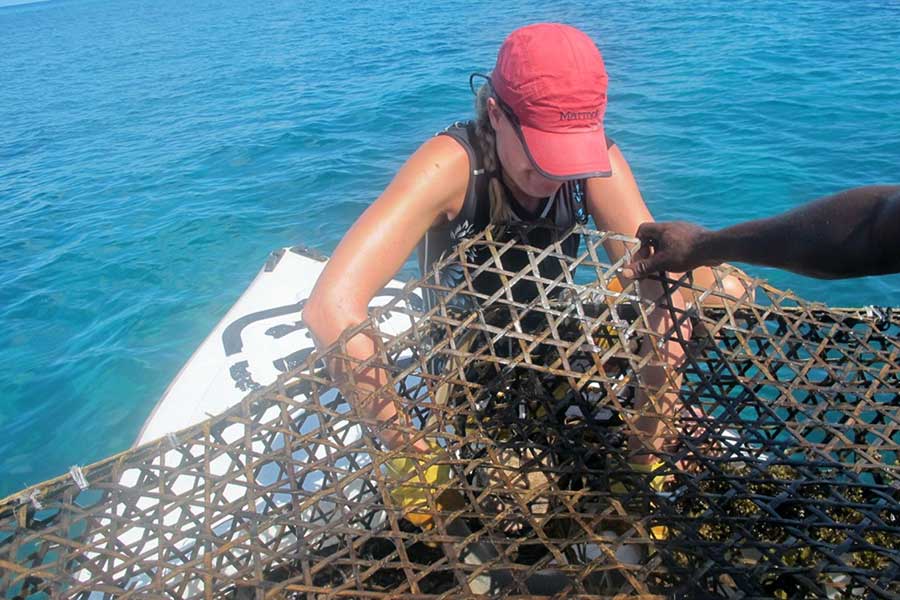
FISH RESEARCHERS CATCH MORE THAN FISH
migratory movements of commercially valuable fish species within the Marine Protected Area of Cousin Island.
As a part of our daily activities, we have been using two bamboo fishing traps to collect members of the target species for tagging and release to track their range of movement during the spawning season. Naturally, we are unable to limit the fish that enter our trap to just those in the target species so we have had a collection of other species, which are released back into the ocean where they were caught.

The quantity of target species trapped has varied vastly with the patterns of the spawning cycle, a variation which has caused some frustrations in our daily trap pulls. At the end of a particularly—how should I put this?—difficult week, which involved releasing far more fish than were tagged, our boatman said he had a good feeling about our luck changing the next week. We said our goodbyes for the weekend hoping that our diligence in successfully releasing all non-target species to happily return to their home territories might pay back in good karma next week.
Monday morning dawned with an extra little glow in the sunshine and sparkle as it reflected off the waves. It was going to be a good day, we could feel it in the air. Adrenaline coursed as we retrieved the buoy for our first trap and began hauling up the water-soaked cage. We laughed, imagining what multitude of animals we might find lurking within. The traps are left without bait for the weekend so we weren’t really expecting much. You can imagine our surprise when, hiding in the far corner of the bamboo, was a large female lobster with her tail laden in a clutch of eggs. As a native to the portion of the United States where lobster is most prevalent, I was thrilled to see this spiny relative up close and personal. After marveling for a moment, we released her and watched something I have never seen before, a swimming lobster. Then we moved on to the next trap, not imagining there would be anything cooler than that. Boy were we wrong. The cage broke the surface of the glassy water to shouts of glee as we spotted an octopus taking shelter in the far corner. Now, I have heard tales and seen videos of impressive octopus escape artistry, but never have I witnessed such impressive body contortions with my own two eyes. This particular specimen, which was occupying about ¼ of the cage, proceeded to poke and prod and twist and wrap and suction its way out of the tiny hole in our little trap. We all watched in awe at this Houdini-esque escape and finally cheered our octopus friend as she happily jetted away.

Tuesday arrived with markedly less excitement. We couldn’t quite imagine what might top our trap inhabitants from the previous day. Well friends, it seems Monday’s bycatch was just a warm up for the main event. Our first cage rose from the depths of the blue with quite a bit more thrashing activity than we have previously seen and it quickly became clear as the trap tipped onto our boat as to why. I am more than mildly obsessed with lobster and octopus, but another member of our research team finds herself dreaming of sharks daily. Naturally, it is only fair that after my day of excitement yesterday, she should have a moment to shine. And sure enough, with a 1 m nurse shark thrashing about in our cage, we had a very happy boat. When I came to the Seychelles for this research opportunity, I never fancied myself much of a shark wrestler. But after today, I have one more interesting skill to add to my CV. With gloves, and as carefully as possible (and with a little help from our boatman), I grabbed this not so docile shark by tail and head, carefully lifting her from the trap to return to the sea. Like the octopus and lobster before her, she swam away to freedom with a very happy snorkeling scientist watching her go. The next cage, which held another octopus, seemed almost anticlimactic as we jaded researchers were still enjoying the afterglow of the shark. However, this octopus was too large to escape through the holes in the trap so our brave boatman carefully pried him and all of his arms from the trap before I hopped into the water and watched him escape.
At this stage we have pulled and reset countless cages and only in these 4 consecutive pulls have we had such interesting stow-aways. I would say karma really was on our side for the start of the week and with that in mind we continue to successfully release every non-target species fish that wanders into our trap. The week was rounded out with a close encounter diving with an inquisitive male Hawksbill turtle and an impromptu snorkel with dolphins. The moral of this story is perhaps good deeds don’t go unnoticed after all.
Elizabeth Martin

